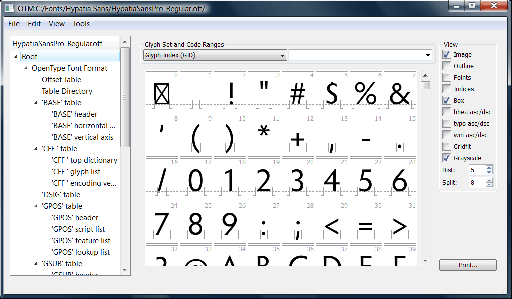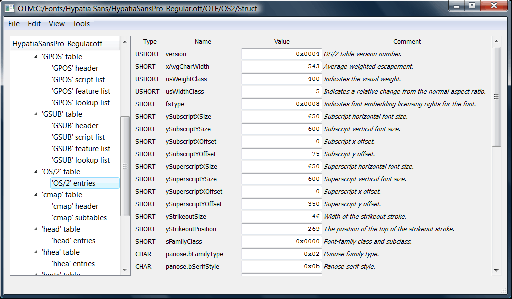So, my old friend Frank Blokland over at the Dutch Type Library recently asked me to take a look at a new tool they were developing. DTL has a whole suite of tools collectively known as DTL FontMaster. OTMaster (OT being short for OpenType), along with its free “Light” version, is a new addition to this suite, and has just shipped.
Basically, OTMaster is a tool for cracking open and looking inside OpenType fonts (or plain old Windows TrueType fonts). It shows a fairly literal/direct representation of what’s in the various tables and subtables. It has a bit of unobtrusive interface and allows direct editing of various fields. This is an excellent tool for font geeks/developers, but not really appropriate for the average end user of fonts.
Here are a couple of screen shots (click on each for full size version):
OT Master glyphs display

OT Master display of OS/2 table

Currently, if I want a simple and accurate representation of the contents of a TrueType or OpenType font, and possibly to edit the info, I have been using the wondrous open source TTX tool, which is based on the FontTools library. This dumps the font info to an XML text file, which can be viewed/edited in any text editor or anything that can handle XML. It can also recompile the text file back into a font. (In fairness, Adobe’s FDK for OpenType also has table dumping/recompiling tools, just not quite as slick as TTX. Even Adobe folks often use TTX.)
Why would I use either OTMaster or TTX instead of, say, FontLab Studio 5? FLS is a great program which I use a lot, but it interprets the OpenType font into its own internal format. It can’t open a font, make a tiny change and re-save it as a font without potentially changing other things. To give a really concrete example, FLS displays font embedding settings in terms of its interpretation of the settings, rather than the actual bits. So if I’m looking at a font with a bogus/illegal embedding setting, I can’t tell, because FontLab won’t show me that, it’ll just default to showing the end result as some legit setting instead. So tools like TTX or OTMaster are really handy for that, because they show the unvarnished truth of what’s in the font, without interpretation.
The downside to tools like TTX and OTMaster is that they make little effort to tell you the meaning of the various cryptic values for various fields (or the exact meaning of the field itself), even when said values are legal/legit. So you need to also have a copy of the OpenType or TrueType specification handy, and optionally a more descriptive, hand-holding tool like FontLab Studio (though one must beware the possibility of it adding or reinterpreting data, as mentioned).
Here’s the public announcement DTL made for OTMaster, on the ATypI mailing list (a great resource, and a major benefit of ATypI membership):
The Dutch Type Library and URW++ Design & Development proudly present DTL OTMaster (OTM), a highly sophisticated application for reviewing, editing and saving tables of fonts with a snft file structure, as there are CFF and TTF flavored OpenType fonts, TrueType fonts and TrueType Collection fonts.
Font editors, like for instance the DTL FontMaster suite, FontLab Studio and FontForge, rely on their own internal data formats for type design and font production. From these data, binary fonts for the end-user are compiled as the last step in the font production process. OTM is a tool for inspecting and adjusting such binary fonts, irrespective of the font editor used for their creation.
OTM makes the editing of tables possible from a graphical user interface. It comes with built-in tools like the Glyph Editor for proofing and editing contours or even drawing glyphs from scratch. A ‘kern’ Table Viewer is available for proofing and refining the kerning, and a ‘GSUB’/’GPOS’ Viewer to visually test (and in case of GPOS also adjust) these OpenType Layout tables.
DTL OTMaster was programmed in Hamburg, Germany at URW++ Design & Development, renowned for pioneering in the field of font technology development for more than thirty years. The FM Team (Dr. Juergen Willrodt, Axel Stoltenberg, Hartmut Schwarz, Peter Rosenfeld and Frank E. Blokland) was joined by Karsten Luecke as advisor and also author of the extensive and detailed OTM manual and Nikola Djurek for the design of the function icons.
OTM is available for Mac OS X, Windows and Linux. Free Light versions are available for:
The downloads also contain the OTM manual in PDF format.
Leave a Reply